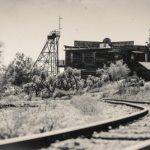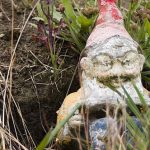 Mysteries
Mysteries  Mysteries
Mysteries  History
History 10 Surprising Stories About the Texas Rangers
 Humans
Humans 10 Philosophers Who Were Driven Mad by Their Own Theories
 Miscellaneous
Miscellaneous 10 Video-Game-Worthy Weapons and Armors from History
 Weird Stuff
Weird Stuff 10 Psychics Who Accurately Predicted Wartime Events
 The Arts
The Arts 10 Pieces of Art Inspired by a Broken Heart
 Health
Health 10 Science Fiction-Sounding New Medical Treatments
 History
History 10 Surprising Facts About the Father of Submarine Warfare
 Space
Space Ten Astonishing New Insights into Alien Worlds
 Weird Stuff
Weird Stuff 10 Bizarre Summer Solstice Rituals Still Practiced Today
 Mysteries
Mysteries Top 10 Haunting Facts About the Ghost Ship MV Alta
 History
History 10 Surprising Stories About the Texas Rangers
 Humans
Humans 10 Philosophers Who Were Driven Mad by Their Own Theories
Who's Behind Listverse?

Jamie Frater
Head Editor
Jamie founded Listverse due to an insatiable desire to share fascinating, obscure, and bizarre facts. He has been a guest speaker on numerous national radio and television stations and is a five time published author.
More About Us Miscellaneous
Miscellaneous 10 Video-Game-Worthy Weapons and Armors from History
 Weird Stuff
Weird Stuff 10 Psychics Who Accurately Predicted Wartime Events
 The Arts
The Arts 10 Pieces of Art Inspired by a Broken Heart
 Health
Health 10 Science Fiction-Sounding New Medical Treatments
 History
History 10 Surprising Facts About the Father of Submarine Warfare
 Space
Space Ten Astonishing New Insights into Alien Worlds
 Weird Stuff
Weird Stuff 10 Bizarre Summer Solstice Rituals Still Practiced Today
Ten Strange Things You Never Knew about the Wild West
They called it the Wild West for a reason. The frontier was a crazy place while America was moving west and settling the previously-untamed region. Gun battles were commonplace. Outlaws ruled in small towns and pop-up villages. Bank robberies, saloon brawls, and all kinds of crazy gambling issues (which we’ll get to in a minute!) were regular parts of life for pioneers.
So it makes sense that the westward expansion brought with it more than a few jaw-dropping tales, right? From daring exploits to shocking violence and brazen acts, the West was won in wild ways difficult to imagine today.
From little-known Civil War skirmishes to supposed UFO sightings (yes, really) and even tales of crazed cannibals and wild camels, the frontier had it all. Beyond Wyatt Earp and Billy the Kid, there were more strange, scandalous, and shocking stories to come out of the frontier than you ever knew. In this list, we’ll cover ten of those surprising stories from the days of the Old West. Let’s saddle up and ride!
Related: 10 Wild West Stories With Modern Developments
10 The Civil War Reached New Mexico
Ask any American about the Civil War, and they’ll tell you about battles that raged up and down the eastern seaboard. From Gettysburg and Antietam to Charleston and Sherman’s march on Georgia, it was all limited to the east… right? Not exactly! As it turned out, there was a very important Civil War skirmish way out west—in New Mexico, to be exact. And it was one of the most important battles of the entire war, at least as far as westward expansion was concerned.
In late March of 1862, New Mexico was a wild backcountry full of untamed land. But the northern part of the area gave settlers access to southern Colorado’s mountainous region. With it came the promise of very lucrative mining territory in the Rocky Mountains. And battling over New Mexico allowed any potential victor basically unfettered access all the way out to California. So while New Mexico may have been a long way from the plantations of the Deep South, its strategic importance for the future of slavery was massive.
Both the Union and the Confederacy knew this. And even though neither side had many men stationed that far west, each group understood how critical it was to lay claim to the land. So, on March 26, 1862, the Battle of Glorieta Pass kicked off. It only involved about 2,500 soldiers, but it turned out to be a decisive early moment in the Civil War.
Texas Confederates claimed victory early on after nearly wiping out a branch of Union militants. But after a few days of brutal fighting, a tough band of New Mexico Volunteers climbed the cliff face of Glorieta Mesa. Gaining the high ground by surprise, they got the angle on a large group of now-defenseless Texans down below.
The Union won the bloody battle—and of course, a few years later, the war. But while it’s not talked about much in the history books today, Glorieta Pass marked a key moment in the fight. Had the Texans taken the area, the Confederacy would have easily pushed west. They could have invaded Arizona and, from there, laid claim to lands in Mexico.
Then, with no opposition, they’d have rolled right through to California. Its coastline would have given them an endless array of options for seaports and shipping lanes. Oh, what could have been if not for that brave 1862 stand in the highlands of New Mexico…[1]
9 Cowboys Saw Aliens
We like to think of alien abduction stories and UFO sightings as a recent phenomenon. As technology has rapidly proliferated over the last hundred or so years, aliens have supposedly descended on us from outer space. But the truth is that UFO claims have been made for centuries. And they were actually somewhat common in the Wild West!
One of the most notable western alien allegations came back in 1896. In the frontier town of Lodi, California, a Civil War veteran and journalist named H.G. Shaw claimed he and a buddy saw a group of extraterrestrials. According to Shaw, who wrote about the incident in the local newspaper, the other-worldly characters “were 7 feet tall and very slender with small hands, fingers without nails, and feet twice as long as normal and functioned similar to a monkey’s feet.”
And he wasn’t done there! The newspaperman even had a theory about why the aliens arrived in the first place. “Those we beheld were inhabitants of Mars,” Shaw wrote in the Lodi News-Sentinel, “who have been sent to the earth for the purpose of securing one of its inhabitants.” Sound familiar? All those alien abduction stories of the past few decades had to start somewhere, after all.
Shaw’s supposed sighting wasn’t the only unsettling UFO event out west. A year after the Lodi incident, citizens of the tiny town of Aurora, Texas, reported seeing cigar-shaped flying saucers cruising high overhead. And a few months after that, the town’s rattled citizens even claimed that “a UFO allegedly slipped from the heavens and exploded in the middle of the town.” Skeptics said it was merely a meteorite, but allegations of an alien visit remained a rumor in town for years after.
Evidently, small-town life way out west gave way to many interesting observations. Whether those were the product of isolation and boredom or legitimate UFO interactions is anybody’s guess. But of course, the most famous alien event did happen out west.
Granted, Roswell took place in 1947, long after the Wild West had been won. And even more recently, the Marfa lights have captured all our extraterrestrial attention. Clearly, the frontier has always been a place of suspicious space sightings—then and now![2]
8 Crazed Cannibals Roamed Nevada
To hear native tribes around modern-day Nevada tell it, there used to be a red-haired band of giant cannibals who roamed the area. They terrorized local native bands across the region thousands of years ago. For centuries, members of the Northern Paiute tribe have been handing down old tales about a supposed tribe of giants called the Si-Te-Cah. According to the Paiute, that tribe was a cannibalistic band of fiery-haired gingers. If that sounds equal parts scary and weird, well, read on.
The Paiute claim the cannibal group used to eat a fibrous water plant that helped turn their hair the fiery color. Then, they would hunt humans all across the high deserts of the Old West long before eastern settlers ever made it out there. Thankfully the Paiute put a stop to all this long ago.
According to a Northern Paiute tribal activist and archivist named Sarah Winnemucca Hopkins, Paiute warriors were able to trap all the Si-Te-Cah clan members in a large, dark cave. Then, the Paiute lit the cave entrance on fire. The cannibals perished inside, never to be heard from again.
According to Hopkins herself, Paiute elders have handed down stories about defeating these giants for many, many years. “My people say that the tribe we exterminated had reddish hair,” Hopkins wrote in a book about Paiute customs. “I have a dress which has been in our family a great many years, trimmed with the reddish hair… It is called a mourning dress, and no one has such a dress but my family.”
And yet even though that legend may be hundreds of years old, it (probably) isn’t entirely true. Modern historians and folklorists think it’s likely there actually was a tribe in the area for whom red hair was a common genetic hand-me-down. However, they almost certainly weren’t giants. They might just have been slightly taller than most regional tribes of the day.
Or, even more likely, the Si-Te-Cah were of normal height, and centuries of oral retellings have turned that myth into a particularly bad game of telephone. Regardless, the legend is now part of Paiute lore. As far as they are concerned, Nevada was once a land of very angry (and very hungry) giants![3]
7 Putting the Hatfields and McCoys to Shame
The Kentucky-West Virginia border’s world-famous Hatfield and McCoy families weren’t the only notorious feuding clans of the old days. In fact, the Old West had a feud that went even further than that infamous incident.
After the Civil War, Texas had two families—the Suttons and the Taylors—who really didn’t like each other. The feud started when Buck Taylor shot and killed a Sutton ally in 1866, then escalated with the deaths of Taylor and a man named Dick Chisholm two years later in a horse sale gone wrong. Taylor’s remaining family members dug in their heels.
They had Southern pride and were mad about the Confederacy losing decisively in the Civil War. The Suttons, meanwhile, had the backing of local Texas militia members and state police outfits that were keen on Reconstruction. The Sutton family’s patriarch, William, took control of the police himself by 1869, running raids across the state to ferret out cattle rustlers sympathetic to the Taylors.
Over the next five years, all of DeWitt County, Texas, was plunged into a horrifically violent feud. Even members of other families were forced to take sides and choose between the Suttons and Taylors. Those who didn’t offer allegiance risked being killed. Then again, those who did pick a team were killed in skirmishes and senseless violence too.
By 1874, so many people had died in DeWitt County that the Texas Rangers finally rode in. They worked for months to ease tensions. They were mostly unsuccessful, but by the end of 1875, the feud started to slow. It wasn’t because of anybody’s particular negotiating skills. It was merely because the most aggressive and vicious feud participants on each side had mostly been killed by then.
The next few years saw several more violent murders, but the rate was thankfully dwindling. By the end of the 1870s, at least 22 Taylor family members had died compared to 13 Suttons. Scores of friends and allies on each side perished amid the senseless violence as well. Then, for the next 20 years, Texas courts tried (in vain) to sort out the legal mess that came from it all. It wasn’t until the end of the 19th century that most family members and friends finally moved on.[4]
6 Oregon (Sort of?) Outlawed Slavery
As the Old West was being settled, slavery was still commonplace throughout the South. After all, as we’ve just learned with Texas’s terrible family rivalry, ex-Confederate soldiers were still fighting a proxy war long after they got home. Before the Civil War, though, even more pressing questions spread across the Plains. Elsewhere in the West, the issue of slavery was still being worked out among newly-formed states.
Take Oregon, for example. The state’s government was first founded way back in 1844. During that time, the state decided it did not want slavery, so a local founding father named Peter Burnett wrote an amendment to “prevent” the heinous act.
In the bill, slavery was stated to always be illegal in Oregon. Furthermore, families who brought slaves to settle in the state would have three years to “remove them out of the country.” And if those slaves weren’t removed after the three-year time limit, they would be deemed free men.
But there was a bizarre catch in that political push: Section 6 of Burnett’s bill made it so that any former slaves who were brought to Oregon and freed had to immediately leave the state. And the penalty for not doing so was incredibly severe.
The bill became known as “Peter Burnett’s lash law” because that final section ordered freed slaves who remained in Oregon to be whipped “not less than twenty or more than thirty-nine stripes.” Essentially, Burnett intended to make it illegal for Black people to ever settle in or live in Oregon.
And by 1849, that’s exactly how the law was interpreted. It’s unclear if any freed slaves were ever brought to Oregon and let loose later to be lashed. But the bill effectively banished Black people from living in the newly-formed state. Burnett was specifically concerned that ex-slave settlers would work to “instill into their minds feelings of hostility toward the white race.” Even more amazingly, the exclusion rule stayed in place in the state all the way up until 1926.[5]
5 Camels Once Roamed the Range
Years before the Transcontinental Railroad became a reality, westward expansion was thought to be possible thanks to camels. Yes, really. Horses were a major part of western culture, of course. But camels could plod along for miles on end carrying considerable weight on their backs. Plus, owing to the desert life baked into millions of years of their evolution, they were theoretically prepared to handle the comparatively less-harsh conditions of the western United States.
So, in the 1840s and 1850s, supply trains began using camels to traipse across shorter journeys in various regions from Texas to Washington. By the late 1850s, a man named Edward Fitzgerald Beale walked several dozen camels all the way to California. Leaving from the Midwest, they completed a 1,200-mile journey to a destination just north of Los Angeles. Pioneers took immediate notice.
One man, a Confederate Major named Henry Wayne, went on record saying, “Americans will be able to manage camels not only as well, but better than Arabs, as they will do it with more humanity and with far greater intelligence.” Casting aside the era’s cold racism, the statement was brimming with positivity about what camels could do for those traveling across the difficult West.
In 1857, the United States government purchased hundreds of camels for logistical purposes and put them out to pasture in Texas. For a few years, they forgot about them—and then the Civil War hit. When it happened, opportunistic Confederates in the state rounded up the beasts and put them to use for the military effort. The camels effectively became known as the Camel Corps.
Some were used to deliver mail and other goods around the region. Others were caught and sold for profit that went into purchasing war goods. At least one died in battle. The 43rd Mississippi Infantry’s camel named Old Douglas became famous after sustaining mortal wounds during the siege of Vicksburg. In the end, the Camel Corps didn’t really work out for the Confederacy.
While camels may have been good at lugging packs on their backs for long stretches, they are both slow and temperamental. Horses (for people) and mules (for supplies) simply proved to be better—pardon the pun—workhorses for the war effort. Over the years after, though, long-since-released wild camels popped up across the West.
One that lived in the brutal Arizona desert came to be known as the Red Ghost. He once trampled a woman to death in a frontier town, and later his legend grew to include all kinds of other tall tales. Wild camels weren’t fated to live out a North American life, though. As the West was won, the few dozen wild camels remaining soon died out and faded from memory.[6]
4 Where Are All the Mines?
While the legend of the camel known as Red Ghost may have been just as much a tall tale as fact, it certainly wasn’t the only myth operating out West. There have been countless legends and rumors about creepy, fantastical, and downright unlikely events. But no frontier myths are more persistent than the intriguing tales of lost mines and unearthed fortunes.
Of course, much of the West was settled after various gold and silver rushes brought men to the land. Thousands of young (and sometimes old) men back east who felt lucky or reckless or were just plain bored struck out West for a chance at a new life.
Most failed miserably while panhandling for gold. But the few who did strike it rich left the rest hoping they could somehow still find that one quick score. Thus, legends quickly spread about supposed lost mines, hidden treasures, and uncovered loot. Miners hid their riches away from prying thieves, these claims clamored, and the gold is still out there waiting to be (re)discovered.
Most (if not all) of those tales were entirely false, of course. But that didn’t stop would-be miners from spreading them around all the same. For decades long after these gold rushes had ended, tales of hidden mines and buried treasure made their way back east. The most famous one—which still draws attention today—is that of the Lost Dutchman’s Gold Mine.
Supposedly set way up in the (aptly titled) Superstition Mountains outside Phoenix, the mine is said to have been first dug out by a German immigrant named Jacob Waltz nearly 200 years ago. For decades after Waltz supposedly left the area, prospectors turned up to search for it. Nobody has ever found it, though—and some people have died trying. And plenty of other alleged uncovered mines across the West hold similar allure.
The Wheelbarrow Mine in Idaho, Adams Diggings in New Mexico, Janni’s Chimney in Washington, and the Lost Blue Bucket Mine in Oregon are all still well-known to mine hunters and modern-day gold diggers.[3]
7 The Crazy Crash at Crush
William Crush was a railroad executive with a penchant for the dramatic. Intent on getting Americans to want to travel by rail during the very end of the 19th century, he opted to go bigger than big. In 1894, he was looking to finance the future of a new railroad venture called the Missouri-Kansas-Texas Railroad Company. Popularly known as the Katy, this rail line needed funds to start up during the age of rail.
So Crush put together a massive carnival at a temporary Texas town that he (of course) named after himself and invited the public to visit. It wasn’t just any carnival, though: the main attraction was to be two 35-ton train engines getting smashed together to show the railroad’s incredible might. Yes, this is what passed for entertainment back in the days of the Old West. And yes, it was a resounding success by all financial and personal accounts—well, except for the people who perished in the awful train crash.
On the day of the planned train collision, Crush was (temporarily) the second-largest city in all of Texas. More than 40,000 people came to the area from all around. Just as he promised, Mr. Crush set off two steam-powered trains down the tracks straight for each other. Each train went down the tracks at well over 50 miles per hour (80.5 km/h).
When they hit, there was a massive explosion that blasted steam, fire, and train parts high up into the sky. Two people were killed in the massive explosion, and hundreds more were injured. But thousands beyond that were sold on the power of the railroad. And one man—a witness named JC Deane—received $10,000 from Crush’s Katy Railroad Company after losing an eye in the awful accident.
The railroad’s overseers were horrified at William Crush’s antics, and fired him after learning about the deadly collision. But days later, after the railroad saw how much public attention was drawn toward them after the shocking show, they quickly rehired Crush and asked for more.
It just goes to show that even way back then, no publicity was bad publicity.[8]
2 Gamblers Put Modern Wagering to Shame
From the ever-present attraction of Las Vegas to the rise of online sports betting in more recent times, gambling has always been a part of American life. It was that way in the Old West too. In one major sense, that’s just how things were: You had to be something of a gambler at heart to strike out West in the first place. So many things could kill a pioneer while they were headed out west that they were all essentially gambling with their lives right as they began the trip. So by the time people got out West, it was well understood they were already feeling lucky.
And as they arrived, it was only natural to pass the time by playing cards—all while trying to make a buck or two to survive. Gambling was such a regular part of life in the Wild West that it was an esteemed job. Like doctors, saloon keepers, lawyers, and other business owners, card sharks and other gamblers won esteem for their work. “In the early West, gambling was considered a profession, as legitimate a calling as the clergy, the law or medicine,” one historian famously wrote.
All across the West, high-stakes games and large potential pots attracted full-time gamblers. Men traveled from town to town, making their money at the card table. Some gamblers resorted to cheating and shady schemes to win against unsuspecting locals. Then, they would take their winnings and quickly skip town before they could be caught.
All the way out in California, professional gambling was practically a religion. Card players traveled there all throughout the 19th century and offered their talents for cash. In the end, it became its own destination for many men seeking to travel through the frontier.[9]
1 The West’s Wild Whiskey Woes
In addition to gambling, whiskey just seemed to hit the spot for people on the frontier. But the whiskeys that were offered up for consumption at the time weren’t exactly things you’d want to drink today. The names alone sounded wild: Forty Rods, Tarantula Juice, Taos Lightning, and all kinds of other exotic-sounding drinks came out West. The truth is they were beyond potent. Many would contain almost unbelievable ingredients—even literal poisons like strychnine.
Other liquors included things like turpentine and tobacco oil. For many people, drinking the first shot required them to purchase a second shot just to wash down and forget about the first. If they could stomach it (literally), the drinker would be so far gone after a couple rounds that they’d forget what they were drinking and drift off into a chemical-induced slumber, only to do it all again the next day.
From a logistical perspective, this probably shouldn’t surprise you. After all, Western saloons were often few and far between. The distances between towns were vast, and the logistics and supply lines were inconsistent at best. And with that, there weren’t any food or beverage regulations being enforced anywhere in the West during the 19th century. So without rules to lay out what whiskey should (and shouldn’t) entail, saloon keepers simply got creative.
Sometimes, they got a little too creative. But at all times, they definitely kept it interesting. Would you drink a shot or two of strychnine or turpentine to get drunk? Just be thankful the West has already been won, and you will never have to answer that question![10]








